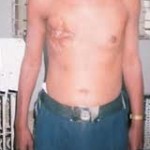 Many people know that although breast cancer is generally considered something that affects women, men can—and sometimes do—develop breast cancer too. But breast cancer isn’t the only “women’s disease” that affects men. Here are two more that most people don’t know about.
Many people know that although breast cancer is generally considered something that affects women, men can—and sometimes do—develop breast cancer too. But breast cancer isn’t the only “women’s disease” that affects men. Here are two more that most people don’t know about.
 Eating disorders. Even though we think of eating disorders as affecting only girls, the fact is that about a third of the country’s 30-million people who suffer from one are male. Unfortunately, there are a number of issues that make it very difficult for these boys and young men to get the help they desperately need.
Eating disorders. Even though we think of eating disorders as affecting only girls, the fact is that about a third of the country’s 30-million people who suffer from one are male. Unfortunately, there are a number of issues that make it very difficult for these boys and young men to get the help they desperately need.
- Most medical professionals don’t even consider it. Even mental health professionals, who really should know better, have a tough time acknowledging it. The American Psychiatric Association, for example, has a nice section on its website devoted to eating disorders, but if you look at the list of symptoms of anorexia, the first one is “Menstrual periods cease.” So, almost by definition, there’s no way a boy could possibly be anorexic. The second symptom—“Osteopenia or osteoporosis (thinning of the bones) through loss of calcium”—is yet another condition that’s generally considered to be a women’s condition.
- A lot of boys and young men know they’ve got a problem but resist getting help because they worry that people will consider them un-masculine. After all, REAL men don’t have eating problems.
- Even when guys do admit to themselves and others that they’ve got an eating disorder, the kinds of facilities that treat girls generally don’t accept males. Again, that makes it especially hard for boys and young men to get treated.
 Osteoporosis. We all know that being overweight increases men’s risk of developing high blood pressure, diabetes, and cardiovascular problems including heart attack and stroke. But a study recently presented at the North American Society for Radiology found that being overweight—especially if that excess fat is worn around the middle—greatly reduces men’s bone strength and makes them more prone to fractures and breaks. And while osteoporosis in women affects mainly those over 60, in men, the effects are apparent even as young as 34.
Osteoporosis. We all know that being overweight increases men’s risk of developing high blood pressure, diabetes, and cardiovascular problems including heart attack and stroke. But a study recently presented at the North American Society for Radiology found that being overweight—especially if that excess fat is worn around the middle—greatly reduces men’s bone strength and makes them more prone to fractures and breaks. And while osteoporosis in women affects mainly those over 60, in men, the effects are apparent even as young as 34.
“If you are a man and you have a little bit of excess fat around the waistline, it should really be a trigger to start thinking about the fact that you are putting yourself at risk…” said Dr. Kevin Campbell, a cardiologist based in Raleigh, N.C., in an interview with Fox News. “Men are never really associated with osteoporosis and this is yet another reason for men to try to trim their waistlines as they age.”



